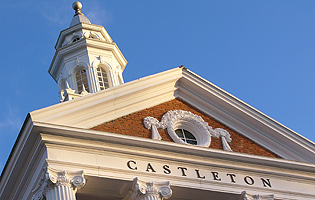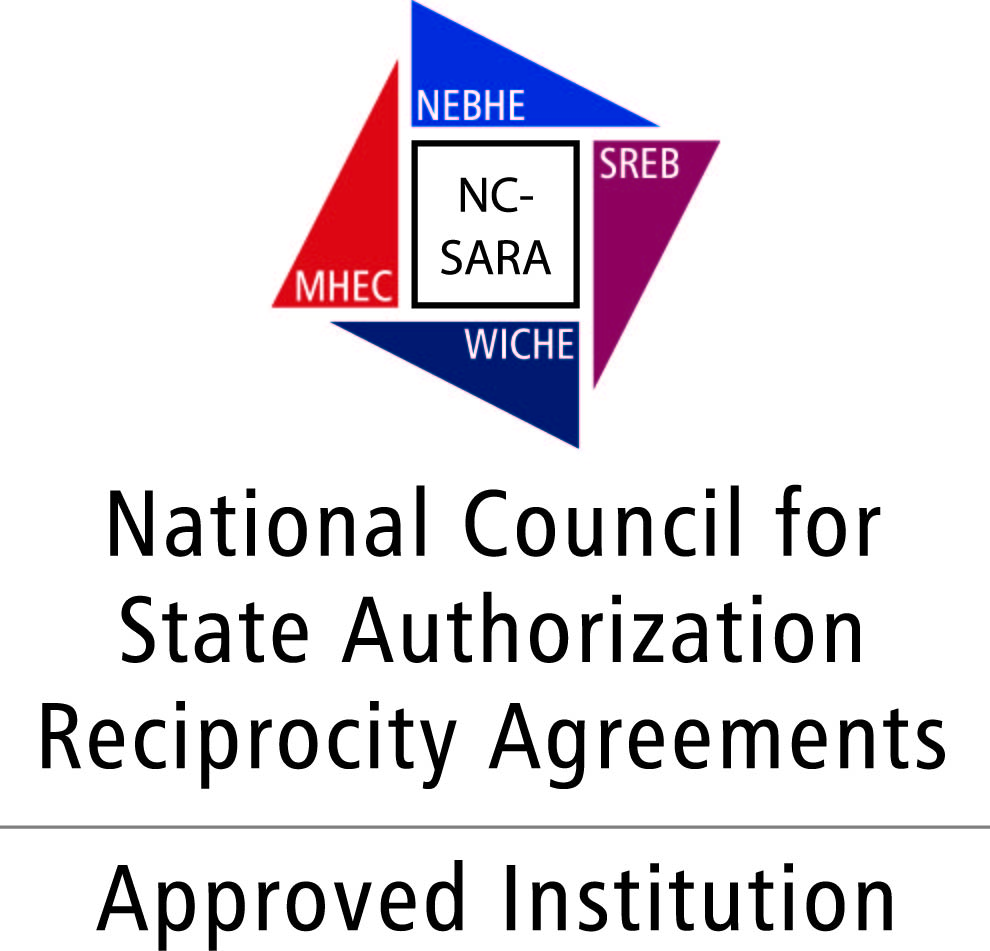
Castleton University
Castleton, Vermont 05735
www.castleton.edu
Castleton University is accredited by the
New England Association of Schools and Colleges.
Mission
Castleton University, the 18th oldest institution of higher education in the United States, emphasizes undergraduate liberal arts and professional education while also offering selected graduate programs.
The university is dedicated to the intellectual and personal growth of students through excellence in teaching, close student-faculty interaction, numerous opportunities for outside-the-classroom learning, and an active and supportive campus community. Castleton strives to learn, use, and teach sustainable practices. The university prepares its graduates for meaningful careers; further academic pursuits; and engaged, environmentally responsible citizenship.
As a member of the Vermont State Colleges, Castleton University is committed to supporting and improving the region's communities, schools, organizations, businesses, and environment.
Location
 Castleton is located in an area that has long been recognized for its beauty, unique character, and recreational resources. The natural environment of Vermont blends easily with the educational environment of Castleton to create the setting for a unique living and learning experience. Castleton is located in an area that has long been recognized for its beauty, unique character, and recreational resources. The natural environment of Vermont blends easily with the educational environment of Castleton to create the setting for a unique living and learning experience.
The university's 165-acre campus is situated in the village of Castleton. One of Vermont's largest cities, Rutland, lies 12 miles to the east; New York State is six miles to the west. Montreal, Boston, Hartford, Albany, and New York City are all within easy driving distance on major highways and are accessible by air, bus, and/or train service.
Faculty and Curriculum
Castleton provides an academic experience that draws from two of the university's greatest strengths. On the one hand, students can enjoy the benefits of small classes in a rural setting and Castleton's two hundred years of tradition. On the other hand, they can profit from contact with highly qualified faculty who are strongly encouraged to develop their teaching skills and research interests. These attributes of the institution receive support from fine academic facilities, particularly an excellent Information Technology Services Center whose growth in recent years in quality and quantity of hardware and software is matched by student and faculty interest.
These ingredients, combined with a diverse population of in-state and out-of-state students, provide variety and challenge for all on a very personal level.
Castleton is primarily a teaching institution whose faculty is dedicated to the preeminence of student learning in the life of the university. Castleton faculty comprise a community of scholar-teachers whose academic and artistic endeavors enlarge and enrich the lives of their students, their colleagues, and the university. Ninety-three percent of the faculty hold doctoral or appropriate terminal degrees in their field of academic specialty. Excellence in teaching requires that professors continue to learn to reexamine established canons of thought and belief, and to expand the frontiers of knowledge through continued study, scholarship, and research. The chief beneficiary of faculty scholarship is the Castleton student, whose classroom experience is heightened by the shared excitement of the professor's own pursuit of knowledge.
History
Castleton University's roots go back to October 15, 1787, when the General Assembly of the State of Vermont chartered the Rutland County Grammar School in the village of Castleton. In early America a grammar school was the first step in higher education, a link between the local common schools and the few colleges in New England. Of institutions that are colleges today, Castleton is the oldest in Vermont and the 18th oldest in the nation.
The village of Castleton was an intellectual center. The first medical college in Vermont was founded here in 1818 and lasted until 1862. In that time the school conferred some 1400 medical degrees, more than any other New England medical school. Students came from throughout the United States, from Canada, and from distant lands including France, Cuba, Ireland, and Brazil. At least two African-Americans graduated and went on to distinguished careers.
Throughout the 19th century, the school in Castleton evolved and changed names to meet the needs of society. In 1829 the cornerstone of the historic Old Seminary building was laid by Solomon Foot, principal of the Classical High School and later president pro tempore of the U.S. Senate during the Civil War, and Colonel Noah Lee, an early settler who had been with Ethan Allen at the capture of Fort Ticonderoga. In the 1860s, Harriet Haskell, later a nationally known feminist, served as Castleton's first woman principal.
In 1867 the State Normal School was founded in Castleton. For a few years it was housed entirely in the old Medical College building and shared faculty with the Castleton Seminary before that school closed. Normal school is a term based on the French école normal, a school to educate teachers. For 30 years Abel Leavenworth, a Civil War hero, and son Philip Leavenworth were principals of the State Normal School. In 1912 the State of Vermont purchased the property.
Castleton entered a Golden Age in the 1920s and 1930s under the leadership of Principal Caroline Woodruff. She helped save the school after the Old Seminary building burned in January 1924. Quoting the Old Testament's book of Haggai, she promised, "And the glory of the latter house shall be greater than that of the former." Woodruff modernized the curriculum, hired excellent staff, and exposed her students to the wider world through guest speakers, who included Robert Frost, Helen Keller, and Norman Rockwell. A friend of Eleanor and Franklin Roosevelt, she is still the only Vermonter to be president of the National Education Association.
In 1947 the Normal School became Castleton Teachers College. With increased enrollment from men, intercollegiate athletics began in the 1950s, and by the early-1960s Castleton was a national power in small college men's soccer.
In 1962 Castleton became a state college and a member of the newly formed Vermont State Colleges. Castleton grew dramatically during the decade of the Sixties in enrollment and in construction of buildings. A generation of faculty educated at major universities brought new perspectives to the classroom. Many academic programs were added to meet the changing needs of students and of society.
Begining in 2002, under the leadership of President David Wolk, Castleton followed through on a ten-year master plan that resulted in the investment of over $75 million in infrastructure improvements on campus, with every current building or facility having been renovated or newly constructed. The college also increased research opportunities for faculty and students, expanded opportunities in athletics and the arts, increased the number of international students, pursued a diversified portfolio of entrepreneurial ventures, and added a number of graduate programs.
Accordingly, after more than a decade of unprecedented growth and improvements, in 2015 the Vermont State Colleges Board of Trustees unanimously approved modernizing Castleton's name to Castleton University.
Today, Castleton University has a total enrollment of more than 2000 students. The university offers more than 30 undergraduate programs and 10 graduate programs. First-year students benefit from the First-Year Seminar program and Soundings, which offers the best in music, drama, dance, and contemporary thought for the campus. The university is deeply involved in the region through community service efforts and internships and through its education, social work, and nursing programs. Our staff and faculty are proud to work here, and our students and alumni are filled with that same Spartan Pride.
Although so much has changed in 228 years, Castleton retains its historic commitment to students and to Vermont.
The Castleton Plan
The fall of 2013 saw the inauguration of The Castleton Plan, a strategic plan and blueprint developed collaboratively over the course of more than a year that envisioned the next ten years at Castleton. Highlighted by new and enhanced graduate programs, with a doctoral program under development, the plan also includes incremental enrollment growth, a focus on international enrollment, and increased opportunities for students in Rutland through entrepreneurial ventures such as the Castleton Downtown Gallery, the Castleton Polling Institute, and Castleton Downtown, which is home to the Center for Community Engagement, Center for Entrepreneurial Programs, and Center for Schools. All of these endeavors, along with the increased on-campus growth of conferences and events and the off-campus growth of the Spartan Arena and soon to be installed Spartan Dome, are entrepreneurial efforts that serve the community but also ease the burden of tuition dollars which make up 90 percent of the yearly operating budget.
The Plan builds on this reinvigoration of the past fourteen years, with well-planned incremental increases in undergraduate and graduate enrollment, staffing, programs and facilities, and with an eye toward a greater investment in and commitment to the Rutland area, including downtown Rutland as a destination for selected new programs for graduate students and upper level undergraduates that will further enhance the quality of a Castleton education while contributing to economic and community development in the greater Rutland region.
The Castleton Plan suggests a measured, incremental process of increased enrollment that seeks to raise admissions standards and increase retention rates while expanding our recruitment efforts into each of the fifty states and all countries where we can develop sound recruitment opportunities.
Additionally, the Plan goes on to say that Castleton will develop a number of exemplary graduate programs, including online and hybrid programs and courses, thereby establishing Castleton as a leader in graduate education and exerting a positive influence on the undergraduate experience.
Finally, the Plan calls for an increase in public and private funding. Moreover, there is a collective effort to restrain tuition increases, add scholarships, and focus on affordability.
This is a tremendously exciting time for Castleton University and our future. Our vision moving forward is a testament to the remarkable progress of recent years. We are proud of what we have accomplished together in a way that embraces our rich history, enhances our cherished traditions, and contributes to the cultural and economic well-being of Vermont and beyond.
Castleton University has been approved by the state of Vermont to participate in the National Council for State Authorization Reciprocity Agreements. NC-SARA is a voluntary, regional approach to state oversight of postsecondary distance education.

|